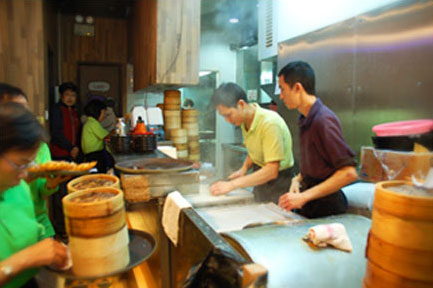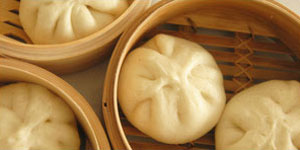 Serving up pork buns to our enthralled restaurant reviewer for pennies.
Serving up pork buns to our enthralled restaurant reviewer for pennies.
It seems an incongruous place to find a rating most chefs would strangle their sous-chefs for. But the gamy Hong Kong district of Mongkok hosts the cheapest starred restaurant in the famed culinary kingdom of the Michelin Guide. It is Tim Ho Wan, a Cantonese eatery that for instance features for just HK$12 (US$1.53) three light, crispy barbeque pork buns filled with a gentle stew of meat chunks swaddled in slightly sweet sauce. These baked buns are largely responsible for not only keeping this restaurant forever busy, but earned it a star that would be the envy of the tens of thousands of chefs in France.
It’s 10.10am on a Saturday, and we’re among 28 other people – a mix of Hong Kong families, elderly friends, and the odd solo diner – sitting at tables and practically inhaling the already-famous dim sum in front of us. Outside the steamed-up glass doors to the small restaurant, another 60 or so people – a few tourists now among them – wait hungrily in line, flipping the large pages of newspapers, hunched over portable gaming consoles or poring over the pages of guide books. One old woman, wrapped up warm in the winter weather, has even brought along a small stool.
We waited an hour and 10 minutes to get in; by the time the outsiders gain entry to the promised land, they will have waited considerably longer. Tim Ho Wan is no longer a secret. Those queues outside the door are as much a feature as those glorious pork buns, and neither will be going away any time soon.
 When the Michelin Guide first launched in Hong Kong in 2008, it met plenty of criticism – as the mythically snobbish French guide invariably does when it enters a new city. Four years after it launched in New York, and two years after it first graced Tokyo, the guide – which is feared as much respected by chefs – hit Hong Kong shelves amid cries of elitism and Western bias. Too many of the starred restaurants were to be found in luxury hotels, critics pointed out, which is hardly where most locals go to eat. The only Hong Kong restaurant to receive the ultimate three stars was Lung King Heen in the Four Seasons Hotel, where a meal for one costs in excess of HK$500.
When the Michelin Guide first launched in Hong Kong in 2008, it met plenty of criticism – as the mythically snobbish French guide invariably does when it enters a new city. Four years after it launched in New York, and two years after it first graced Tokyo, the guide – which is feared as much respected by chefs – hit Hong Kong shelves amid cries of elitism and Western bias. Too many of the starred restaurants were to be found in luxury hotels, critics pointed out, which is hardly where most locals go to eat. The only Hong Kong restaurant to receive the ultimate three stars was Lung King Heen in the Four Seasons Hotel, where a meal for one costs in excess of HK$500.
At the press launch for its 2010 edition, the Michelin team were at pains to stress the Chinese cuisine credentials of their anonymous reviewers and the guide is this year loaded with roast goose restaurants, noodle joints and congee shops. Cheapest on the list, and most prominent among the one-star ranks, was Tim Ho Wan, opened in early 2009 by Mak Pui Gor – the former dim sum chef at Lung King Heen.
When Chef Mak shifted his talents across Victoria Harbor from Central to the decidedly more downmarket shopping area of Mong Kok, he took with him his reputation and put fine Chinese dining – albeit in small portions – firmly into the affordable column. Here, cooks flip pastry and stuff dumplings in a narrow and crowded kitchen area behind a tall pane of glass that separates it from the unfussy dining area.
Five waitresses in bright green T-shirts weave in and out of the narrow aisles, bearing steaming-hot pots of chrysanthemum tea and stacks of bamboo baskets as they swerve expertly between the tightly-packed-in tables (there’s seating for exactly 30 people at one time) to deliver the food to expectant, and now super hungry, diners, who order extra dishes to take home in polystyrene boxes.
Squeezed into a tiny cul-de-sac between the door and the first table, a man sits on a stool and busily tallies up new receipts as the extra orders keep flowing in. But while most dim sum restaurants are cacophonous affairs, Tim Ho Wan is today strangely muted as the diners dedicate themselves to wolfing down the fare rather than share in idle chit-chat.
Next to arrive at our table are three beef balls, each the size of a baby’s fist, looking brain-like as they sit in paddling pools of vinegar and soy sauce, wearing capes of bean curd and topped with heapings of coriander. They are thick and succulent, and while firm to the bite they hold together as if they are an organic whole.
They’re quickly followed by some slightly over-moist fried turnip cakes served with chili sauce, before we devour four plump pieces of siu mai, stuffed with chunks of fresh shrimp. In short order, we also relieve the restaurant of four piping hot pieces of har gao, savouring the perfectly steamed shrimp, mixed in with pork fat and scallion and wrapped tightly in dumpling skin. The dim sum here disappears as quickly as it arrives and is the best in its class: simple, fresh and generally light on grease.
Before long, we take note of the eager faces almost pressed to the glass looking in from the outside. It’s only been 20 minutes, but we feel implicit pressure to vacate our coveted seats. After a few stabs with small plastic forks at a jasmine tea jelly embedded with flower petals, we reluctantly sidle over to the counter in the cul de sac, hand over our paper receipt and fork out HK$90. It’s a tiny price to pay for a small slice of Michelin history.
Tim Ho Wan, Flat 8, Ground Floor, Phase 2, Tsui Yuen Mansion, 2-20 Kwong Wa St, Mong Kok, Kowloon, Hong Kong.
|
|
Tweet |






25 Comments to A Michelin Star in Mongkok | Comments Feed
Reading your site I am positive that i may well recognize you from high school, did happen to visit Tx Technology? If you ever did please shoot me an email so we can easily get caught up it’s been a very long time! Anticipate conversing with you and hope virtually all will be good with you.
Amazing stuff thanks 🙂
For sharing this great article! That is really interesting Smile I like reading and I am always hunting for educational information like this.
It became a lot more common with the introduction of Digg, which mixed Delicious and Slashdot’s characteristics.
Valuable article and excellent design you got here! I would like to thank you for sharing your thoughts and time into the stuff you post!! Thumbs up
I’m wondering now if we can talk about your sites statistics – search volume, etc, I’m trying to sites I can buy adspace through – let me know if we can talk about pricing and whatnot. Cheers mate you’re doing a great job though.
That’s way the best answer so far!
Tim Ho Wan is totally awesome. I visited recently, and had to wait more than 4 hours! But, completely worth it. Hope you don’t mind, but here is some updated info on Tim Ho Wan dim sum:
A Guide to Tim Ho Wan
Nate, Thanks for your coments on Tim Ho Wan, and what a heroic effort – 4 hours waiting for Dim Sum – your are truly a Wandering Palate. For those who may have missed the link on Nate’s write up, he it is again http://www.yomadic.com/tim-ho-wan/
Bravo!
Thank you very much Curtis, much appreciated!
I really like it when people come together and share thoughts.
Great blog, continue the good work!
The comments are closed.